Module 5 Lao She Teahouse.Unit 2课件(共74张PPT)
文档属性
| 名称 | Module 5 Lao She Teahouse.Unit 2课件(共74张PPT) | 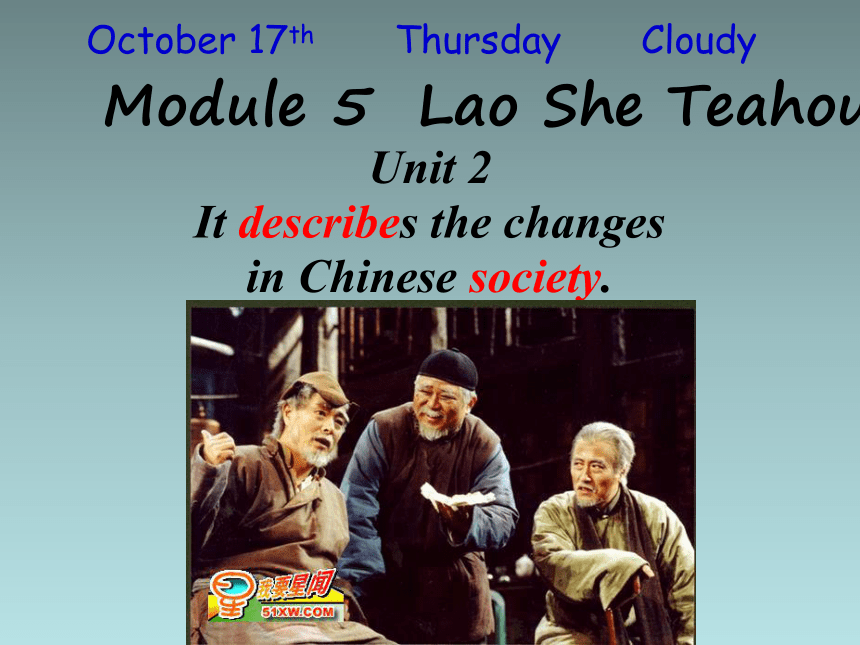 | |
| 格式 | ppt | ||
| 文件大小 | 4.5MB | ||
| 资源类型 | 教案 | ||
| 版本资源 | 外研版 | ||
| 科目 | 英语 | ||
| 更新时间 | 2022-07-31 11:44:32 | ||
图片预览

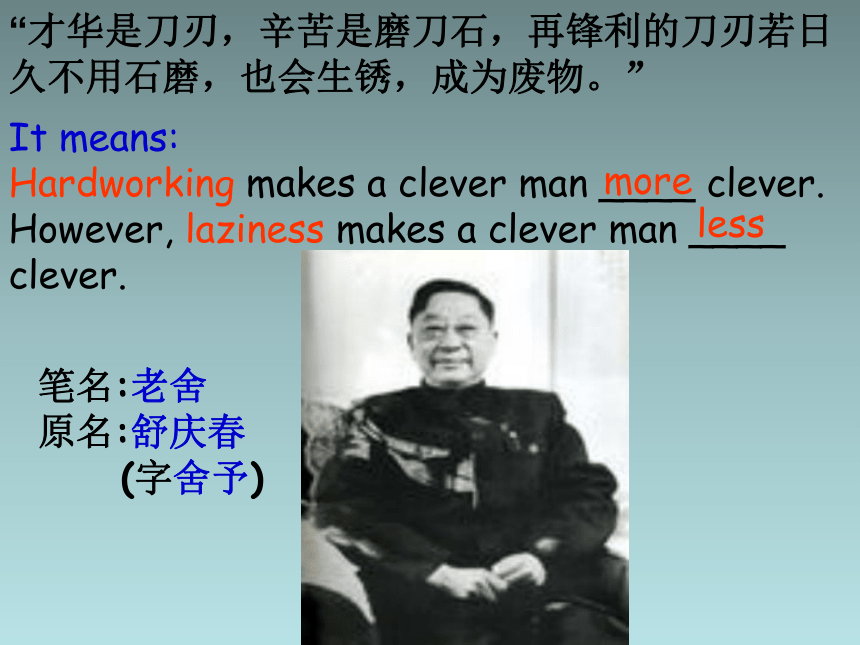
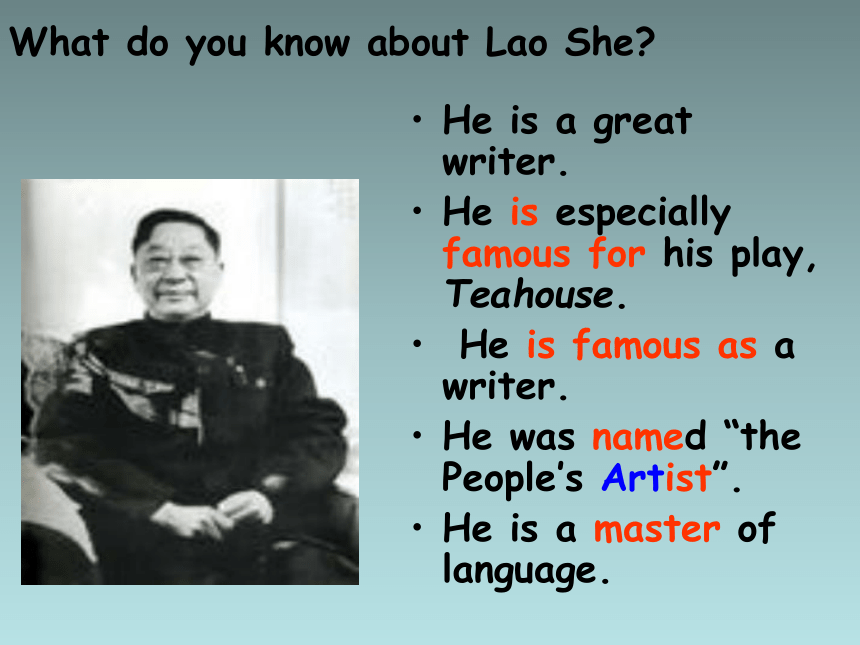
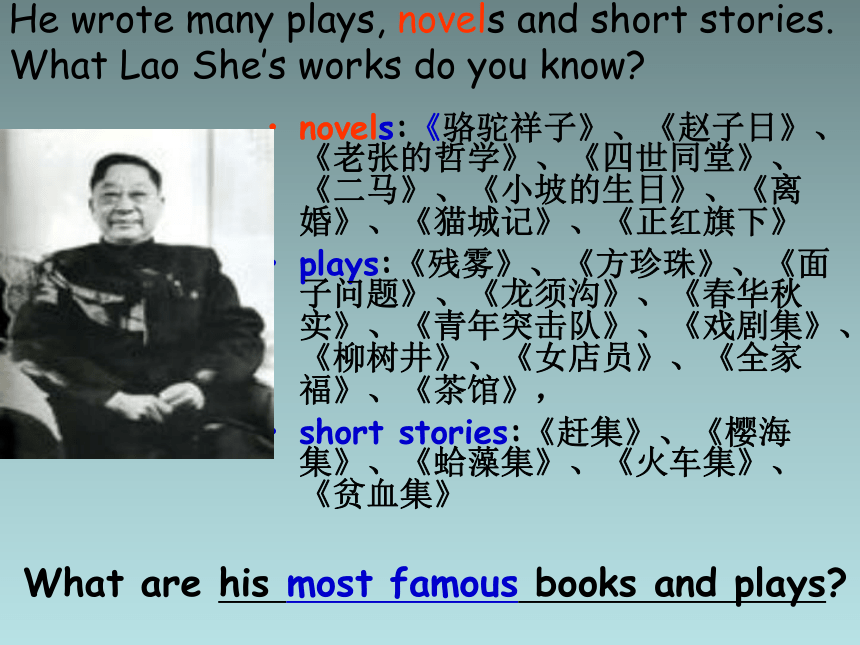
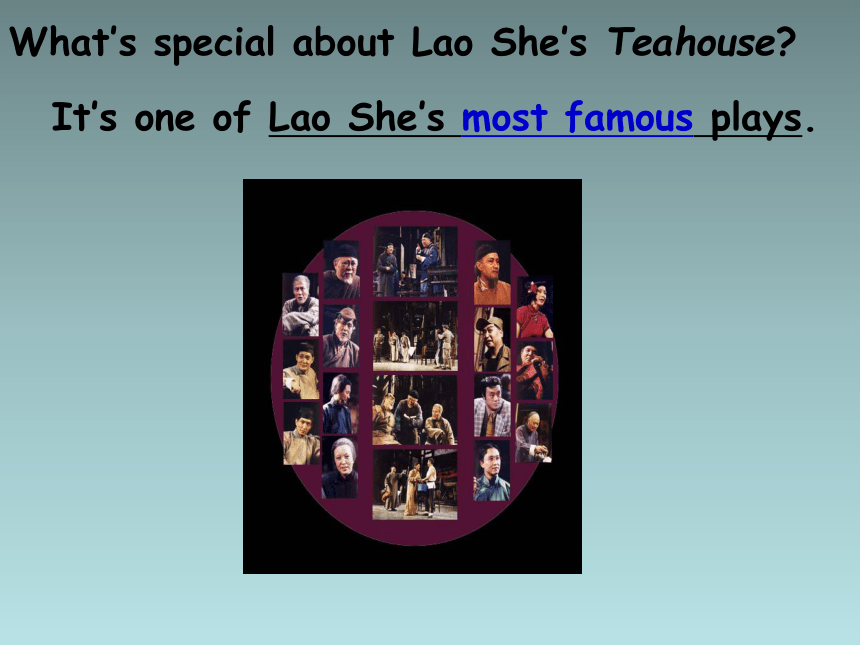
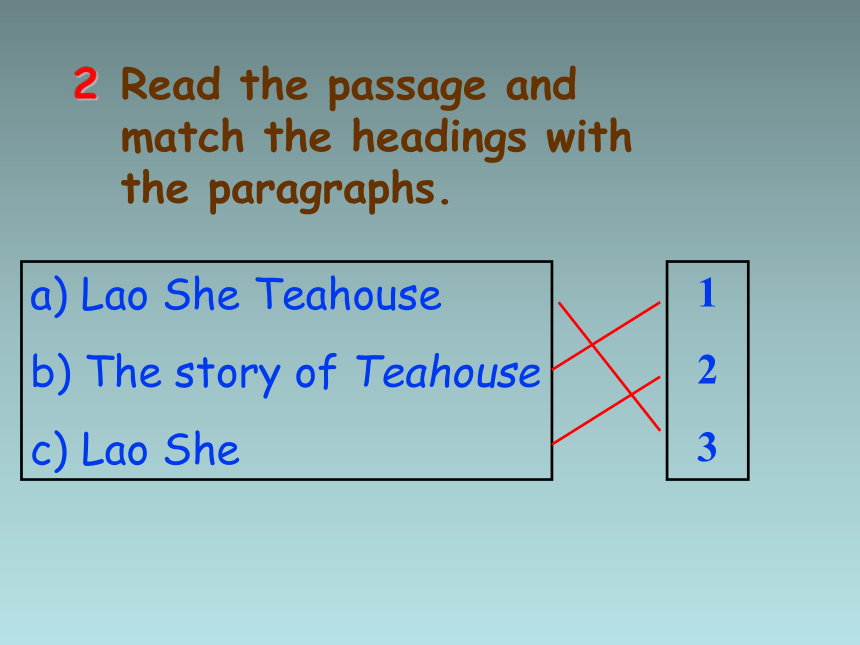

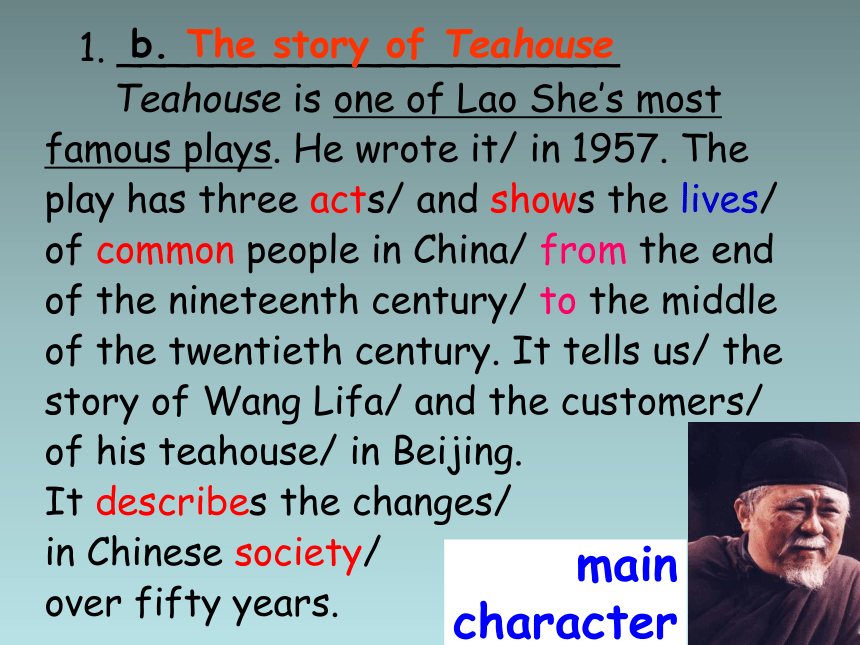
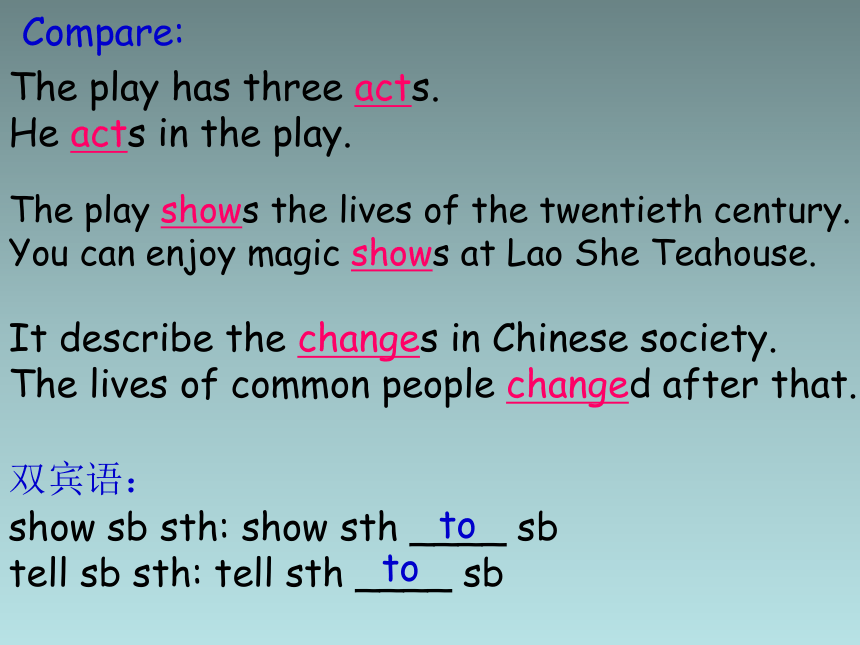
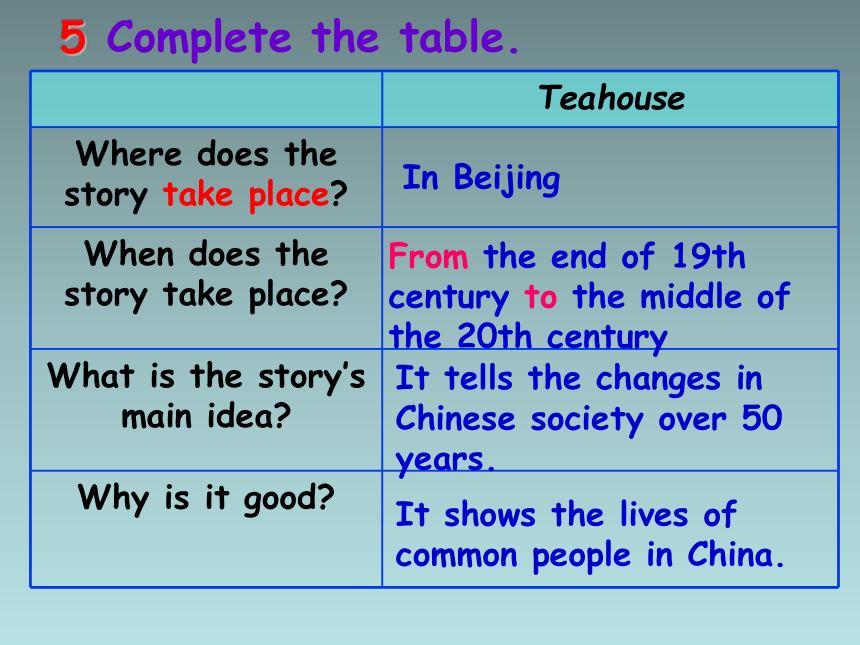
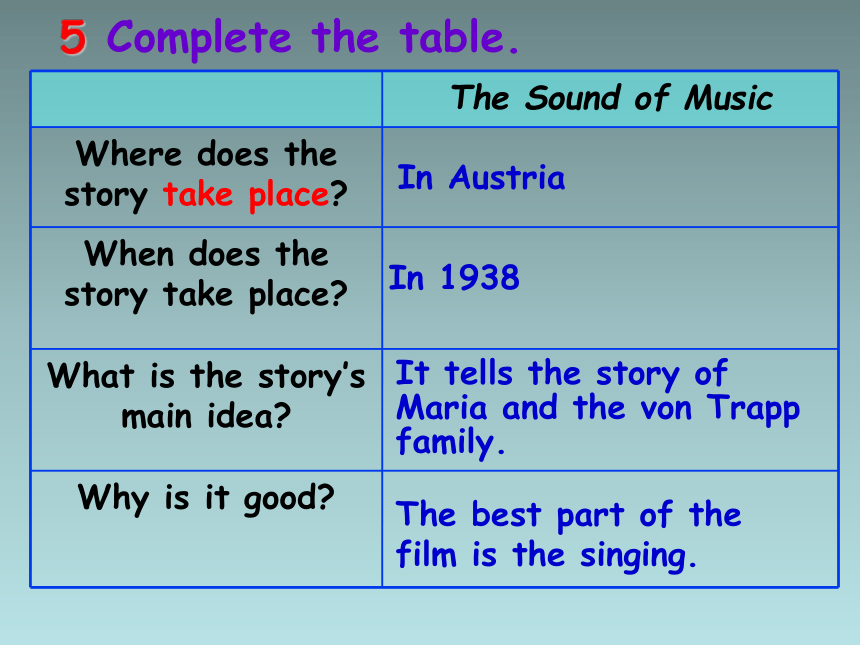
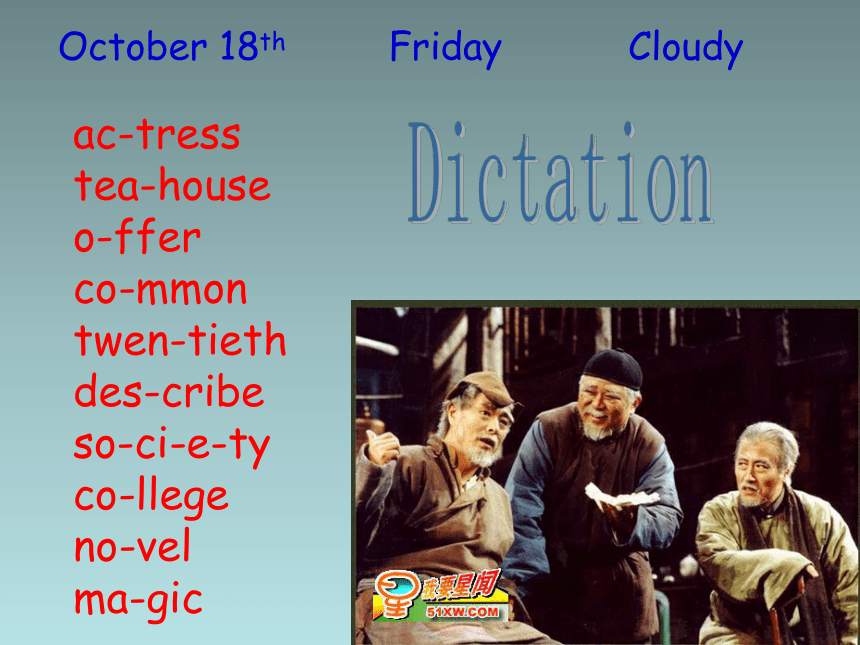
文档简介
(共74张PPT)
Module 5 Lao She Teahouse
Unit 2
It describes the changes
in Chinese society.
October 17th Thursday Cloudy
“才华是刀刃,辛苦是磨刀石,再锋利的刀刃若日久不用石磨,也会生锈,成为废物。”
It means:
Hardworking makes a clever man ____ clever.
However, laziness makes a clever man ____ clever.
more
less
笔名:老舍
原名:舒庆春
(字舍予)
What do you know about Lao She
He is a great writer.
He is especially famous for his play, Teahouse.
He is famous as a writer.
He was named “the People’s Artist”.
He is a master of language.
He wrote many plays, novels and short stories. What Lao She’s works do you know
novels:《骆驼祥子》、《赵子日》、《老张的哲学》、《四世同堂》、《二马》、《小坡的生日》、《离婚》、《猫城记》、《正红旗下》
plays:《残雾》、《方珍珠》、《面子问题》、《龙须沟》、《春华秋实》、《青年突击队》、《戏剧集》、《柳树井》、《女店员》、《全家福》、《茶馆》,
short stories:《赶集》、《樱海集》、《蛤藻集》、《火车集》、《贫血集》
What are his most famous books and plays
What’s special about Lao She’s Teahouse
It’s one of Lao She’s most famous plays.
Read the passage and match the headings with the paragraphs.
Lao She Teahouse
The story of Teahouse
Lao She
1
2
3
2
When you read a passage, remember to look at its title, the paragraph headings and the photos if there are any. They will help you understand the main ideas.
1. _____________________
Teahouse is one of Lao She’s most famous plays. He wrote it/ in 1957. The play has three acts/ and shows the lives/ of common people in China/ from the end of the nineteenth century/ to the middle of the twentieth century. It tells us/ the story of Wang Lifa/ and the customers/ of his teahouse/ in Beijing.
It describes the changes/
in Chinese society/
over fifty years.
b. The story of Teahouse
main character
Compare:
The play has three acts.
He acts in the play.
It describe the changes in Chinese society.
The lives of common people changed after that.
双宾语:
show sb sth: show sth ____ sb
tell sb sth: tell sth ____ sb
to
to
The play shows the lives of the twentieth century.
You can enjoy magic shows at Lao She Teahouse.
Complete the table.
Teahouse
Where does the story take place
When does the story take place
What is the story’s main idea
Why is it good
It shows the lives of common people in China.
In Beijing
From the end of 19th century to the middle of the 20th century
It tells the changes in Chinese society over 50 years.
5
Complete the table.
The Sound of Music
Where does the story take place
When does the story take place
What is the story’s main idea
Why is it good
The best part of the film is the singing.
In Austria
In 1938
It tells the story of Maria and the von Trapp family.
5
ac-tress
tea-house
o-ffer
co-mmon
twen-tieth
des-cribe
so-ci-e-ty
co-llege
no-vel
ma-gic
October 18th Friday Cloudy
Lao She
born:
died:
real name:
pen name:
was named :
1899
1966
Shu Qingchun
Lao She
“the People’s Artist”
a “Great Master of
Language”
2 _____________
Lao She was born/ in Beijing /in 1899. His mother sent him/ to a teacher's school/ in 1913. After finishing school/ in 1918, he became a head teacher/ of a primary school. In 1924, Lao She left home/ and went to England. He taught Chinese/ at a college/ in London/ and returned to China/ five years later. He wrote many plays, novels/ and short stories/ about people’s lives, and was named / “the People's Artist ". Lao She is one of the greatest Chinese writers/ of the twentieth century.
c. Lao She
Complete the timeline with information about Lao She.
______________________________________________________________________________________________________________________________________________________________________________
1957
1924
1918
1913
1899
wrote Teahouse
left home and went to England
finished school and became a head teacher of a primary school
went to a teacher’s school
born in Beijing
3
Lao She was born in Beijing/ in 1899. In 1913 his parents _____ him/ to a teacher’s school in Beijing. He studied there ___ five years and then _____ a head teacher. From 1924 to 1929/ he ______ Chinese/ at a college in London. He ______ many plays, novels and short stories. He was _____ “the People’s Artist”. He is one of the greatest Chinese ______/ of the 20th century.
sent
for
taught
wrote
writers
named
became
To memorize(纪念) Lao She and this play,
people built Lao She Teahouse in 1988.
The teahouse ____ ____ ____ Lao She and his famous play Teahouse.
was named after
drink tea
eat delicious
Beijing food
There is a lot to do and see
at Lao She Teahouse.
see the Beijing Opera
watch magic shows
listen to
traditional music
customers
Lao She Teahouse ____ ____ ___ ____ ____ everyone from/ all over the world.
waiter
双宾语:
give sb sth: give sth ____ sb
to
gives a warm
welcome to
4 ____________________
At Lao She Teahouse today, customers can drink tea /and eat delicious Beijing food. If you like the Beijing Opera, traditional music/or magic shows, you can enjoy them/ at the teahouse. Lao She Teahouse/ gives a warm welcome to everyone/ from all over the world.
a. Lao She Teahouse
Lao She’s play, Teahouse, has three acts.
It describes the life of Wang Lifa and the changes to the lives of (1) _______ people in Chinese (2) ______ in the first half of the twentieth (3) _______.
Lao She went to a teacher’s school in Beijing, taught in London and later returned to China. He is one of China’s greatest (4)_______.
Come to Lao She Teahouse in Beijing (5)___ you like the Beijing Opera, traditional music or (6)_____ shows.
common
society
century
writers
if
magic
Complete the passage with the words in the box.
century common if magic society writers
4
Work in pairs. Ask and answer the questions about Lao She.
What do you know about Lao She
What are his most famous books and plays
What’s special about Lao She’s teahouse
1
Module 10 Lao She Teahouse
Unit 2 It takes place in a teahouse.
December 10th Friday Sunny
take place
audience
customer
dynasty
(lost lost) lose
master
twentieth
waiter
folk
acrobatics
war
the Anti-Japanese War
magic
magic shows
发生
n. 观众
n. 顾客
n. 朝代,王朝
v. 失去,失败
n. 大师
num. 第二十
n. 男服务员
adj. 民间的
n. 杂技表演
n. 战争
抗日战争
n. 魔术
魔术表演
2 Match the words with their meaning:
1. part of a town (where people live)
2. to start doing something again after stopping
3. fighting between countries
4. to happen
5. a person (buying things)
6. people (watching a play or film )
audience customer continue
neighbourhood take place war
neighbourhood
continue
war
take place
customer
audience
Work in groups:
What do you know about Lao She
What do you know about Lao She Teahouse
What do you know about Lao She’s play, Teahouse
Characters in Teahouse
王利发
常四爷
松二爷
崔久峰
1 Read the passage and match the headings with the paragraphs.
A . The story of Teahouse
B . Lao She Teahouse
C . The play Teahouse
D . Lao She
1. __________________
Lao She wrote Teahouse/ in 1957. The play shows the audience/ life in China/ between 1898 /and 1945. It takes place /in a teahouse /in old Beijing /and it tells us/ the story of Wang Lifa and his customers. It asks us /to see the teahouse /as the centre of the neighbourhood. Finally, it says goodbye/ to old Beijing and its people.
C The play Teahouse
2. _____________________
The story starts/ in 1898 /during the Qing Dynasty. It continues/ in 1916, and finally, it brings the audience/ to the end of the Anti-Japanese War /in 1945. After the war, Wang loses the teahouse /and he dies.
A. The story of Teahouse
3 __________________
Lao She was born/ in Beijing /in 1899. His parents sent him/ to the Teacher's School/ in Beijing/ and he learned to teach. From 1924/ to 1929/ he taught Chinese/ to the English/ in London. He wrote many plays, novels and short stories. He was named /a " People's Artist " /and a "Great Master of Language ". He was one of the greatest Chinese writers/ of the 20th century.
D. Lao She
4 ____________________
In Lao She Teahouse today, waiters bring tea /to the customers /and sell them/ delicious Chinese food. If you like Beijing Opera, folk music, acrobatics /or magic shows, you can enjoy them/ in the teahouse. Lao She Teahouse/ gives a wonderful welcome/ to everyone/ from China/ and from all over the world.
B. Lao She Teahouse
1. 在……之间
2. 发生
3. 讲故事
4. 叫某人做某事
5.看做
6. 和某人告别
7. 抗日战争末期
8. 清朝时期
9. 从……到
10. 被称作
11. 伟大的语言大师
12. 人民艺术家
13. 热情欢迎……
Let’s learn
between …… and
take place
tell the story
ask sb to do sth.
see…as
say goodbye to sb.
the end of the Anti-Japanese War
the Qing Dynasty
from …… to
be called/named
Great Master of Language
People’s Artist
give a wonderful welcome to
December 13th Monday Rainy
take place
audience
customer
dynasty
(lost lost) lose
master
twentieth
waiter
folk
acrobatics
war
the Anti-Japanese War
magic
magic shows
发生
n. 观众
n. 顾客
n. 朝代,王朝
v. 失去,失败
n. 大师
num. 第二十
n. 男服务员
adj. 民间的
n. 杂技表演
n. 战争
抗日战争
n. 魔术
魔术表演
The play shows __________ life in China between 1898 and 1945.
2. It asks us _______ the teahouse as the centre of the neighborhood.
It says ________ to old Beijing and its people.
4. Then Wang loses ___________.
Lao She learned ________ at the Teacher’s School in Beijing.
6. Lao She taught _______ to the English in London.
the audience
to see
goodbye
the teahouse
to teach
Chinese
3 Complete the sentences.
What does the play show the audience
Where does the play Teahouse take place
What story does the play tell us
4. When does the story start
5. What war is it in the story
6. Where did Lao She learn to teach
7. Who did Lao She teach Chinese to in London
8. What was he named by people
9. What can you enjoy in Lao She Teahouse
Ask and answer in pairs:
Lao She wrote Teahouse/ in 1957. The play shows the audience/ life in China/ between 1898 and 1945. It takes place/ in a teahouse/ in old Beijing/ and it tells us/ the story of Wang Lifa and his customers. It asks us to see the teahouse/ as the centre of the neighbourhood. Finally, it says goodbye to old Beijing/ and its people.
The story starts in 1898/ during the Qing Dynasty. It continues in 1916, and finally, it brings the audience/ to the end of the Anti-Japanese War/ in 1945. After the war, Wang loses the teahouse/ and he dies.
Lao She was born in Beijing/ in 1899. His parents _____ him/ to the Teacher’s School in Beijing and he ______ to teach. From 1924 to 1929/ he ______ Chinese/ to the English in London. He ______ many plays, novels and short stories. He was named a “People’s Artist”/ and a “Great Master of Language”. He _____ one of the greatest Chinese writers/ of the 20th century.
sent
learned
taught
wrote
was
In Lao She Teahouse today, waiters _____ tea/ to the customers/ and _____ them delicious Chinese food. If you ____ Beijing Opera, folk music, acrobatics or magic shows, you can _____ them/ in the teahouse. Lao She Teahouse/ _____ a wonderful welcome/ to everyone from China/ and from all over the world.
bring
sell
like
enjoy
gives
The play Teahouse
wrote
shows
takes place
tells
asks
says
The story of Teahouse
starts 1898
continues 1916
brings 1945
loses
dies
Lao She
was born
sent
learned
taught
wrote
was named
was
Lao She Teahouse
bring
sell
like can enjoy
gives a wonderful welcome to
Grammar: 双宾语
结构:动词+人+物 → 动词+物 + to/for +人
(“物”是直接宾语,“人”是间接宾语。)
常见的接双宾语的动词:give, bring, pass, offer, send, lend,
show, leave, teach, sell, // buy, cook, read, sing, make, mend等。
1. The play shows the audience life in China between 1898 and 1945.
2. From 1924 to 1929 he taught Chinese to the English in London.
3. In Lao She Teahouse today, waiters bring tea to the customers and sell them delicious Chinese food.
4. Lao She Teahouse gives a wonderful welcome to everyone from China and from all over the world.
What’s the name of it
Where does it take place
3.Who is in it
4.What’s the story
5.What is the best part
6.What’s the writer’s opinion
4 Answer the questions:
The Sound of Music.
In Austria.
Maria and the von Trapp family.
Maria goes to look after the seven children of von Trapp. In the end, Captain von Trapp falls in love with Maria and marries her.
The singing.
It is very beautiful and interesting.
My favorite film is the Sound of Music. It takes place in Austria /in 1938. It’s the story of Maria /and the von Trapp family. Maria goes to look after the seven children. Their father, Captain von Trapp, tells Maria/ to make them study hard. However, she takes them out/ to play. In the end, the captain falls in love with Maria /and marries her. Julie Andrews /plays Maria. She’s very pretty /and she sings beautifully. The best part/ of the film /is the singing. It’s very beautiful and interesting.
Let's read.
Writing
Write a passage about the last film or play you saw.
Use Activities 4 and 5 to help you.
bring tea to the customers 给顾客端来茶水
bring sth to sb=bring sb sth
2. sell them delicious Chinese food
sell sb sth=sell sth to sb
3. gives a warm welcome to everyone
give sth to sb=give sb sth
show the audience life in China=
show life in China to the audience
Read and find out双宾语
teach Chinese to the students in London =teach them Chinese
6. send me a present=send a present to me
7. buy him a bike=buy a bike for him
cook her a meal=cook a meal for her
make kites for them=make them kites
read a book for the boy=read the boy a book
Module 10重点短语讲解
1. fall in love 意思是“爱上”,fall in love with sb. 意为“爱上某人”。如:
She fell in love with the kind man. 她爱上了那个善良的人。
2. be famous for ... as
意为“以……而著称;以……而闻名”。如:
New York is famous for its shopping and nightlife. 纽约以购物和夜生活而著名。
3. in the end
表示“终于”。
如:
He will be a scientist in the end.
最终他将会成为一名科学家。
1. happen: 发生(偶然,意外)
假如我们迟到了会发生什么事情呢 .
What will happen if we are late
happen to do sth.(sb.)
碰巧,发生在某人身上
e.g.: (1)当小车经过时我碰巧在那
I happened to be there when the car
ran past me.
(2) 昨天你发生什么事了?
What happened to you yesterday
2. take place 发生,举行(有计划)
e.g.: (1) 奥运会每四年举行一次.
The Olympic Games take
place every four years.
(2) 北京发生了很大的改变。
Great changes have taken place
in Beijing.
过关练:
1. 最后,我们向她道别。
2. 老师经常要求我们准时上学。
3. 让我们热烈欢迎参观者。
Finally, we said goodbye to her.
The teacher often asks us to go to
school on time.
Let’s give a wonderful welcome to the visitors.
过关练:
4. 这些年我们家乡发生了很大变化。
5. 他想游遍全世界。
Great changes have taken place in our hometown
He would like to travel
all over the world.
waiter
customer
waitress
Would you like to be a waiter or a waitress
Why or why not
Qing Dynasty
silver
Do you know the money of the Qing Dynasty
performance
audience
What are they watching Can you guess
watch the performance
acrobatics
Instrumental performance
Beijing Opera
Cross Talk
Magic show
Just talk about the picture.
A. The story of Teahouse
B. Lao She Teahouse
C. The play Teahouse
D. Lao She
Read and listen .
D:\Personal\administrator\Desktop\新建文件夹\m10text.exe
Unit 2
It takes place in a teahouse.
Listen and watch.
10U2A1.MP3
Lao She wrote Teahouse in 1957. The play shows the audience life in China between 1898 and 1945. It takes place in a teahouse in old Beijing and it tells us the story of Wang Lifa and his customers. It asks us to see the teahouse as the centre of the neighbourhood. Finally, it says goodbye to old Beijing and its people.
The story starts in 1898 during the Qing Dynasty. It continues in 1916, and finally, it brings the audience to the end of the Anti-Japanese War in 1945. After the war, Wang loses the teahouse and he dies.
Lao She was born in Beijing in 1899. His parents _____ him to the Teacher’s School in Beijing and he ______ to teach. From 1924 to 1929 he ______ Chinese to the English in London. He ______ many plays, novels and short stories. He was named a “People’s Artist” and a “Great Master of Language”. He _____ one of the greatest Chinese writers of the 20th century.
sent
learned
taught
wrote
was
In Lao She Teahouse today, waiters _____ tea to the customers and _____ them delicious Chinese food. If you ____ Beijing Opera, folk music, acrobatics or magic shows, you can _____ them in the teahouse. Lao She Teahouse _____ a wonderful welcome to everyone from China and from all over the world.
bring
sell
like
enjoy
gives
Read the passage again and
complete the sentences:
The play shows _____________ life in
China between 1898 and 1945.
It asks us ____________ the teahouse as
the centre of the neighborhood.
3. It says ___________ to old Beijing and its people.
the audience
to see
goodbye
4. Then Wang loses _____________.
5. Lao She learned ________at
the Teacher’s School in Beijing.
6. Lao She taught _________to the
English in London.
the teahouse
to teach
Chinese
Module 5 Lao She Teahouse
Unit 2
It describes the changes
in Chinese society.
October 17th Thursday Cloudy
“才华是刀刃,辛苦是磨刀石,再锋利的刀刃若日久不用石磨,也会生锈,成为废物。”
It means:
Hardworking makes a clever man ____ clever.
However, laziness makes a clever man ____ clever.
more
less
笔名:老舍
原名:舒庆春
(字舍予)
What do you know about Lao She
He is a great writer.
He is especially famous for his play, Teahouse.
He is famous as a writer.
He was named “the People’s Artist”.
He is a master of language.
He wrote many plays, novels and short stories. What Lao She’s works do you know
novels:《骆驼祥子》、《赵子日》、《老张的哲学》、《四世同堂》、《二马》、《小坡的生日》、《离婚》、《猫城记》、《正红旗下》
plays:《残雾》、《方珍珠》、《面子问题》、《龙须沟》、《春华秋实》、《青年突击队》、《戏剧集》、《柳树井》、《女店员》、《全家福》、《茶馆》,
short stories:《赶集》、《樱海集》、《蛤藻集》、《火车集》、《贫血集》
What are his most famous books and plays
What’s special about Lao She’s Teahouse
It’s one of Lao She’s most famous plays.
Read the passage and match the headings with the paragraphs.
Lao She Teahouse
The story of Teahouse
Lao She
1
2
3
2
When you read a passage, remember to look at its title, the paragraph headings and the photos if there are any. They will help you understand the main ideas.
1. _____________________
Teahouse is one of Lao She’s most famous plays. He wrote it/ in 1957. The play has three acts/ and shows the lives/ of common people in China/ from the end of the nineteenth century/ to the middle of the twentieth century. It tells us/ the story of Wang Lifa/ and the customers/ of his teahouse/ in Beijing.
It describes the changes/
in Chinese society/
over fifty years.
b. The story of Teahouse
main character
Compare:
The play has three acts.
He acts in the play.
It describe the changes in Chinese society.
The lives of common people changed after that.
双宾语:
show sb sth: show sth ____ sb
tell sb sth: tell sth ____ sb
to
to
The play shows the lives of the twentieth century.
You can enjoy magic shows at Lao She Teahouse.
Complete the table.
Teahouse
Where does the story take place
When does the story take place
What is the story’s main idea
Why is it good
It shows the lives of common people in China.
In Beijing
From the end of 19th century to the middle of the 20th century
It tells the changes in Chinese society over 50 years.
5
Complete the table.
The Sound of Music
Where does the story take place
When does the story take place
What is the story’s main idea
Why is it good
The best part of the film is the singing.
In Austria
In 1938
It tells the story of Maria and the von Trapp family.
5
ac-tress
tea-house
o-ffer
co-mmon
twen-tieth
des-cribe
so-ci-e-ty
co-llege
no-vel
ma-gic
October 18th Friday Cloudy
Lao She
born:
died:
real name:
pen name:
was named :
1899
1966
Shu Qingchun
Lao She
“the People’s Artist”
a “Great Master of
Language”
2 _____________
Lao She was born/ in Beijing /in 1899. His mother sent him/ to a teacher's school/ in 1913. After finishing school/ in 1918, he became a head teacher/ of a primary school. In 1924, Lao She left home/ and went to England. He taught Chinese/ at a college/ in London/ and returned to China/ five years later. He wrote many plays, novels/ and short stories/ about people’s lives, and was named / “the People's Artist ". Lao She is one of the greatest Chinese writers/ of the twentieth century.
c. Lao She
Complete the timeline with information about Lao She.
______________________________________________________________________________________________________________________________________________________________________________
1957
1924
1918
1913
1899
wrote Teahouse
left home and went to England
finished school and became a head teacher of a primary school
went to a teacher’s school
born in Beijing
3
Lao She was born in Beijing/ in 1899. In 1913 his parents _____ him/ to a teacher’s school in Beijing. He studied there ___ five years and then _____ a head teacher. From 1924 to 1929/ he ______ Chinese/ at a college in London. He ______ many plays, novels and short stories. He was _____ “the People’s Artist”. He is one of the greatest Chinese ______/ of the 20th century.
sent
for
taught
wrote
writers
named
became
To memorize(纪念) Lao She and this play,
people built Lao She Teahouse in 1988.
The teahouse ____ ____ ____ Lao She and his famous play Teahouse.
was named after
drink tea
eat delicious
Beijing food
There is a lot to do and see
at Lao She Teahouse.
see the Beijing Opera
watch magic shows
listen to
traditional music
customers
Lao She Teahouse ____ ____ ___ ____ ____ everyone from/ all over the world.
waiter
双宾语:
give sb sth: give sth ____ sb
to
gives a warm
welcome to
4 ____________________
At Lao She Teahouse today, customers can drink tea /and eat delicious Beijing food. If you like the Beijing Opera, traditional music/or magic shows, you can enjoy them/ at the teahouse. Lao She Teahouse/ gives a warm welcome to everyone/ from all over the world.
a. Lao She Teahouse
Lao She’s play, Teahouse, has three acts.
It describes the life of Wang Lifa and the changes to the lives of (1) _______ people in Chinese (2) ______ in the first half of the twentieth (3) _______.
Lao She went to a teacher’s school in Beijing, taught in London and later returned to China. He is one of China’s greatest (4)_______.
Come to Lao She Teahouse in Beijing (5)___ you like the Beijing Opera, traditional music or (6)_____ shows.
common
society
century
writers
if
magic
Complete the passage with the words in the box.
century common if magic society writers
4
Work in pairs. Ask and answer the questions about Lao She.
What do you know about Lao She
What are his most famous books and plays
What’s special about Lao She’s teahouse
1
Module 10 Lao She Teahouse
Unit 2 It takes place in a teahouse.
December 10th Friday Sunny
take place
audience
customer
dynasty
(lost lost) lose
master
twentieth
waiter
folk
acrobatics
war
the Anti-Japanese War
magic
magic shows
发生
n. 观众
n. 顾客
n. 朝代,王朝
v. 失去,失败
n. 大师
num. 第二十
n. 男服务员
adj. 民间的
n. 杂技表演
n. 战争
抗日战争
n. 魔术
魔术表演
2 Match the words with their meaning:
1. part of a town (where people live)
2. to start doing something again after stopping
3. fighting between countries
4. to happen
5. a person (buying things)
6. people (watching a play or film )
audience customer continue
neighbourhood take place war
neighbourhood
continue
war
take place
customer
audience
Work in groups:
What do you know about Lao She
What do you know about Lao She Teahouse
What do you know about Lao She’s play, Teahouse
Characters in Teahouse
王利发
常四爷
松二爷
崔久峰
1 Read the passage and match the headings with the paragraphs.
A . The story of Teahouse
B . Lao She Teahouse
C . The play Teahouse
D . Lao She
1. __________________
Lao She wrote Teahouse/ in 1957. The play shows the audience/ life in China/ between 1898 /and 1945. It takes place /in a teahouse /in old Beijing /and it tells us/ the story of Wang Lifa and his customers. It asks us /to see the teahouse /as the centre of the neighbourhood. Finally, it says goodbye/ to old Beijing and its people.
C The play Teahouse
2. _____________________
The story starts/ in 1898 /during the Qing Dynasty. It continues/ in 1916, and finally, it brings the audience/ to the end of the Anti-Japanese War /in 1945. After the war, Wang loses the teahouse /and he dies.
A. The story of Teahouse
3 __________________
Lao She was born/ in Beijing /in 1899. His parents sent him/ to the Teacher's School/ in Beijing/ and he learned to teach. From 1924/ to 1929/ he taught Chinese/ to the English/ in London. He wrote many plays, novels and short stories. He was named /a " People's Artist " /and a "Great Master of Language ". He was one of the greatest Chinese writers/ of the 20th century.
D. Lao She
4 ____________________
In Lao She Teahouse today, waiters bring tea /to the customers /and sell them/ delicious Chinese food. If you like Beijing Opera, folk music, acrobatics /or magic shows, you can enjoy them/ in the teahouse. Lao She Teahouse/ gives a wonderful welcome/ to everyone/ from China/ and from all over the world.
B. Lao She Teahouse
1. 在……之间
2. 发生
3. 讲故事
4. 叫某人做某事
5.看做
6. 和某人告别
7. 抗日战争末期
8. 清朝时期
9. 从……到
10. 被称作
11. 伟大的语言大师
12. 人民艺术家
13. 热情欢迎……
Let’s learn
between …… and
take place
tell the story
ask sb to do sth.
see…as
say goodbye to sb.
the end of the Anti-Japanese War
the Qing Dynasty
from …… to
be called/named
Great Master of Language
People’s Artist
give a wonderful welcome to
December 13th Monday Rainy
take place
audience
customer
dynasty
(lost lost) lose
master
twentieth
waiter
folk
acrobatics
war
the Anti-Japanese War
magic
magic shows
发生
n. 观众
n. 顾客
n. 朝代,王朝
v. 失去,失败
n. 大师
num. 第二十
n. 男服务员
adj. 民间的
n. 杂技表演
n. 战争
抗日战争
n. 魔术
魔术表演
The play shows __________ life in China between 1898 and 1945.
2. It asks us _______ the teahouse as the centre of the neighborhood.
It says ________ to old Beijing and its people.
4. Then Wang loses ___________.
Lao She learned ________ at the Teacher’s School in Beijing.
6. Lao She taught _______ to the English in London.
the audience
to see
goodbye
the teahouse
to teach
Chinese
3 Complete the sentences.
What does the play show the audience
Where does the play Teahouse take place
What story does the play tell us
4. When does the story start
5. What war is it in the story
6. Where did Lao She learn to teach
7. Who did Lao She teach Chinese to in London
8. What was he named by people
9. What can you enjoy in Lao She Teahouse
Ask and answer in pairs:
Lao She wrote Teahouse/ in 1957. The play shows the audience/ life in China/ between 1898 and 1945. It takes place/ in a teahouse/ in old Beijing/ and it tells us/ the story of Wang Lifa and his customers. It asks us to see the teahouse/ as the centre of the neighbourhood. Finally, it says goodbye to old Beijing/ and its people.
The story starts in 1898/ during the Qing Dynasty. It continues in 1916, and finally, it brings the audience/ to the end of the Anti-Japanese War/ in 1945. After the war, Wang loses the teahouse/ and he dies.
Lao She was born in Beijing/ in 1899. His parents _____ him/ to the Teacher’s School in Beijing and he ______ to teach. From 1924 to 1929/ he ______ Chinese/ to the English in London. He ______ many plays, novels and short stories. He was named a “People’s Artist”/ and a “Great Master of Language”. He _____ one of the greatest Chinese writers/ of the 20th century.
sent
learned
taught
wrote
was
In Lao She Teahouse today, waiters _____ tea/ to the customers/ and _____ them delicious Chinese food. If you ____ Beijing Opera, folk music, acrobatics or magic shows, you can _____ them/ in the teahouse. Lao She Teahouse/ _____ a wonderful welcome/ to everyone from China/ and from all over the world.
bring
sell
like
enjoy
gives
The play Teahouse
wrote
shows
takes place
tells
asks
says
The story of Teahouse
starts 1898
continues 1916
brings 1945
loses
dies
Lao She
was born
sent
learned
taught
wrote
was named
was
Lao She Teahouse
bring
sell
like can enjoy
gives a wonderful welcome to
Grammar: 双宾语
结构:动词+人+物 → 动词+物 + to/for +人
(“物”是直接宾语,“人”是间接宾语。)
常见的接双宾语的动词:give, bring, pass, offer, send, lend,
show, leave, teach, sell, // buy, cook, read, sing, make, mend等。
1. The play shows the audience life in China between 1898 and 1945.
2. From 1924 to 1929 he taught Chinese to the English in London.
3. In Lao She Teahouse today, waiters bring tea to the customers and sell them delicious Chinese food.
4. Lao She Teahouse gives a wonderful welcome to everyone from China and from all over the world.
What’s the name of it
Where does it take place
3.Who is in it
4.What’s the story
5.What is the best part
6.What’s the writer’s opinion
4 Answer the questions:
The Sound of Music.
In Austria.
Maria and the von Trapp family.
Maria goes to look after the seven children of von Trapp. In the end, Captain von Trapp falls in love with Maria and marries her.
The singing.
It is very beautiful and interesting.
My favorite film is the Sound of Music. It takes place in Austria /in 1938. It’s the story of Maria /and the von Trapp family. Maria goes to look after the seven children. Their father, Captain von Trapp, tells Maria/ to make them study hard. However, she takes them out/ to play. In the end, the captain falls in love with Maria /and marries her. Julie Andrews /plays Maria. She’s very pretty /and she sings beautifully. The best part/ of the film /is the singing. It’s very beautiful and interesting.
Let's read.
Writing
Write a passage about the last film or play you saw.
Use Activities 4 and 5 to help you.
bring tea to the customers 给顾客端来茶水
bring sth to sb=bring sb sth
2. sell them delicious Chinese food
sell sb sth=sell sth to sb
3. gives a warm welcome to everyone
give sth to sb=give sb sth
show the audience life in China=
show life in China to the audience
Read and find out双宾语
teach Chinese to the students in London =teach them Chinese
6. send me a present=send a present to me
7. buy him a bike=buy a bike for him
cook her a meal=cook a meal for her
make kites for them=make them kites
read a book for the boy=read the boy a book
Module 10重点短语讲解
1. fall in love 意思是“爱上”,fall in love with sb. 意为“爱上某人”。如:
She fell in love with the kind man. 她爱上了那个善良的人。
2. be famous for ... as
意为“以……而著称;以……而闻名”。如:
New York is famous for its shopping and nightlife. 纽约以购物和夜生活而著名。
3. in the end
表示“终于”。
如:
He will be a scientist in the end.
最终他将会成为一名科学家。
1. happen: 发生(偶然,意外)
假如我们迟到了会发生什么事情呢 .
What will happen if we are late
happen to do sth.(sb.)
碰巧,发生在某人身上
e.g.: (1)当小车经过时我碰巧在那
I happened to be there when the car
ran past me.
(2) 昨天你发生什么事了?
What happened to you yesterday
2. take place 发生,举行(有计划)
e.g.: (1) 奥运会每四年举行一次.
The Olympic Games take
place every four years.
(2) 北京发生了很大的改变。
Great changes have taken place
in Beijing.
过关练:
1. 最后,我们向她道别。
2. 老师经常要求我们准时上学。
3. 让我们热烈欢迎参观者。
Finally, we said goodbye to her.
The teacher often asks us to go to
school on time.
Let’s give a wonderful welcome to the visitors.
过关练:
4. 这些年我们家乡发生了很大变化。
5. 他想游遍全世界。
Great changes have taken place in our hometown
He would like to travel
all over the world.
waiter
customer
waitress
Would you like to be a waiter or a waitress
Why or why not
Qing Dynasty
silver
Do you know the money of the Qing Dynasty
performance
audience
What are they watching Can you guess
watch the performance
acrobatics
Instrumental performance
Beijing Opera
Cross Talk
Magic show
Just talk about the picture.
A. The story of Teahouse
B. Lao She Teahouse
C. The play Teahouse
D. Lao She
Read and listen .
D:\Personal\administrator\Desktop\新建文件夹\m10text.exe
Unit 2
It takes place in a teahouse.
Listen and watch.
10U2A1.MP3
Lao She wrote Teahouse in 1957. The play shows the audience life in China between 1898 and 1945. It takes place in a teahouse in old Beijing and it tells us the story of Wang Lifa and his customers. It asks us to see the teahouse as the centre of the neighbourhood. Finally, it says goodbye to old Beijing and its people.
The story starts in 1898 during the Qing Dynasty. It continues in 1916, and finally, it brings the audience to the end of the Anti-Japanese War in 1945. After the war, Wang loses the teahouse and he dies.
Lao She was born in Beijing in 1899. His parents _____ him to the Teacher’s School in Beijing and he ______ to teach. From 1924 to 1929 he ______ Chinese to the English in London. He ______ many plays, novels and short stories. He was named a “People’s Artist” and a “Great Master of Language”. He _____ one of the greatest Chinese writers of the 20th century.
sent
learned
taught
wrote
was
In Lao She Teahouse today, waiters _____ tea to the customers and _____ them delicious Chinese food. If you ____ Beijing Opera, folk music, acrobatics or magic shows, you can _____ them in the teahouse. Lao She Teahouse _____ a wonderful welcome to everyone from China and from all over the world.
bring
sell
like
enjoy
gives
Read the passage again and
complete the sentences:
The play shows _____________ life in
China between 1898 and 1945.
It asks us ____________ the teahouse as
the centre of the neighborhood.
3. It says ___________ to old Beijing and its people.
the audience
to see
goodbye
4. Then Wang loses _____________.
5. Lao She learned ________at
the Teacher’s School in Beijing.
6. Lao She taught _________to the
English in London.
the teahouse
to teach
Chinese
同课章节目录
- Module 1 How to learn English
- Unit 1 Let's try to speak English as much as possi
- Unit 2 You should smile at her.
- Unit 3 Language in use .
- Module 2 My home town and my country
- Unit 1 It's taller than many other buildings.
- Unit 2 Cambridge is a beautiful city in the east o
- Unit 3 Language in use .
- Module 3 Sports.
- Unit 1 Nothing is more exciting than playing tenni
- Unit 2 This year we training more carefully.
- Unit 3 Language in use .
- Module 4 Planes, ships and trains .
- Unit 1 He lives the farthest from school.
- Unit 2 What is the best way to travel.
- Unit 3 Language in use .
- Module 5 Lao She Teahouse.
- Unit 1 I wanted to see the Beijing Opera.
- Unit 2 It descibes the changes in Chinese society.
- Unit 3 Language in use .
- Module 6 Animals in danger.
- Unit 1 It allows people to get closer to them .
- Unit 2 The WWF is working hard to save them all.
- Unit 3 Language in use .
- Revision module A
- Module 7 A famous story
- Unit 1 Alice was sitting with her sister by the ri
- Unit 2 She was thinking about her cat.
- Unit 3 Language in use .
- Module 8 Accidents
- Unit 1 While the car were changing to red, a car s
- Unit 2 I was trying to pick it up when it bite me
- Unit 3 Language in use .
- Module 9 Population
- Unit 1 The population of China is about 1.37 billi
- Unit 2 Arnwick was a city with 200,000 people.
- Unit 3 Language in use .
- Module 10 The weathe
- Unit 1 It might snow.
- Unit 2 The weather is fine all year round.
- Unit 3 Language in use .
- Module 11 Way of life
- Unit 1 In China ,we open a gift later.
- Unit 2 In England, you usually drink tea with milk
- Unit 3 Language in use .
- Module 12 Help
- Unit 1 What should we do before help arrives?
- Unit 2 Stay away from windows and heavy furniture.
- Unit 3 Language in use .
- Revision module B
